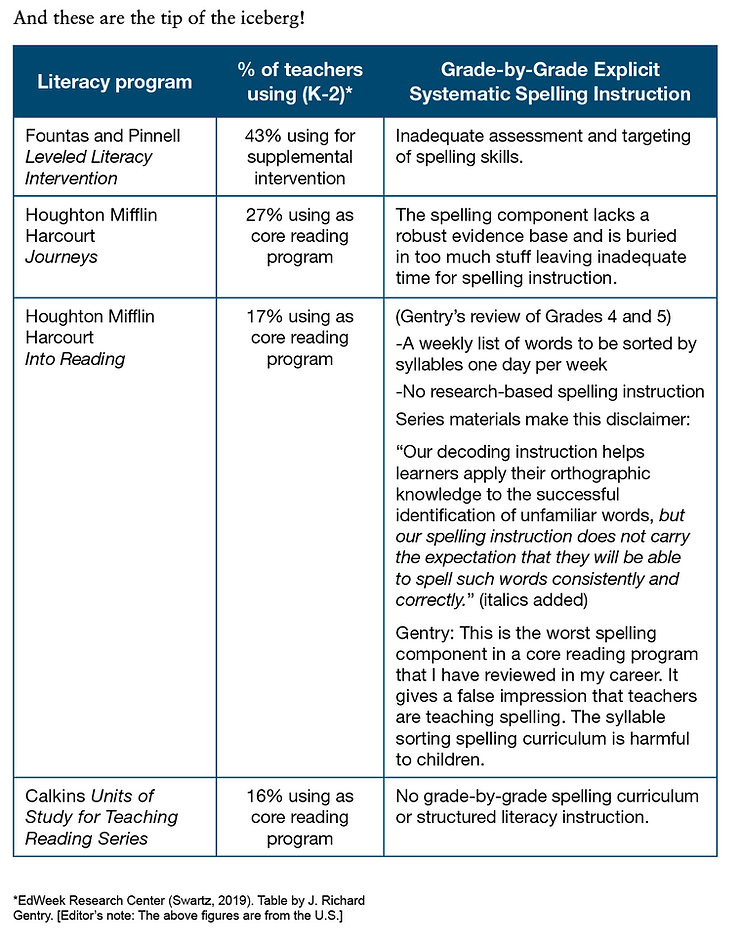An excerpt from … ‘A deep dive into phonemic proficiency’ (Bell, 2023)
Nicola Bell article from Nomanis 15 Sept 2023

After decades of neglect due to flawed whole language theory, the importance of explicit spelling instruction for reading comprehension is finally getting due diligence in research, paving the way for a resurgence of teaching English spelling in today’s classrooms.
By J. Richard Gentry
The spelling-to-read movement spotlights the importance of spelling for orthographic mapping and spelling’s role in automatic word reading which drives reading comprehension. The critical role of spelling for reading is a focus in recent refereed journals in neuroscience and cognitive psychology as well as in recent books by reading scientists and educators (see for example Gentry & Ouellette, 2019; Moats, 2020; Seidenberg, 2017). Landmark studies linking the research to practice have appeared in journals such as Developmental Psychology and Neuroimage. Spelling to read is not only trending in education journals, but in news reports, the media, and with dyslexia advocates and parent groups.
What happened to spelling instruction over the last three decades?
Explicit spelling instruction met its demise with the advent of whole language theory, aspects of which are now wholly debunked by science but regrettably continue to be practised in classrooms. The late Ken Goodman, whom I studied with and greatly admired for many worthy contributions to reading education, such as promoting humanism and equity for all children, respect and advocacy for teachers, support for writing as a process, and other positive ideals, was quite wrong about spelling, phonics and handwriting.
In What’s Whole in Whole Language (1986), Professor Goodman catapulted four harmful core educational principles based on flawed theoretical assumptions. These principles have dominated reading education for three decades with perhaps the most disappointing and hurtful being a full-frontal attack on phonics and explicit spelling instruction. The recommendations below from What’s Whole in Whole Language (1986) are direct and unambiguous:
Do not teach phonics explicitly because children will intuit phonics by reading. [A settled body of research says that was wrong.]
Do not use spelling books or teach spelling explicitly and systematically. Expect children to pick up spelling skills simply by reading and writing. [A settled body of research says that was wrong.]
Do not teach handwriting explicitly. Handwriting instruction is too laborious and impedes written expression. [A settled body of research says that was wrong.]
Since literacy develops from whole to part [a false assumption], there is no hierarchy of sub-skills or logical grade-by-grade sequence. [A settled body of research says that was wrong. As it turns out, serial sub-lexical skills are foundational for the development of reading brain circuitry.]
These four debunked principles must all be addressed to improve reading instruction moving forward. With much due respect, I am unapologetic for focusing on the four whole language signature missteps because all four are simple to correct. Schools and districts that continue to embrace the four misguided principles or use published curricula that embrace them (see the list below) must simply acknowledge these errors and correct them. It’s not complicated.
In a nation and elsewhere where 60% or more children by standardised measures read below proficiency, there is a moral imperative to correct these missteps, especially in schools with vulnerable populations of children who struggle with literacy. The importance that children be taught spelling for reading is incontrovertible.
Sustaining nuggets of wisdom from notable scientists and researchers on the role of spelling for reading
From cognitive psychologist Dan Willingham, in Raising Kids Who Read (2015). Professor Willingham writes that good readers all read by matching what’s on the page with spelling images in the brain.
“[U]sing word spellings to read requires very little attention, if any. You see it [the word on the page] in the same way you just see and recognize a dog … As your child gains reading experience, there is a larger and larger set of words that he can read using the spelling, and so his reading becomes faster, smoother, and more accurate. That’s called fluency.” (Willingham, 2015, p. 133)
From reading scientist and thought leader in the science of reading Professor Mark Seidenberg, in Language at the Speed of Sight: How We Read, Why So Many Can’t, and What Can Be Done About It (2017):
“In neuroimaging studies, poor readers show atypically low activity in a part of the brain that processes the spelling of words.” (Seidenberg, 2017, p. 10)
From Professors Gene Ouellette and Monique Sénéchal’s landmark study in Developmental Psychology (2017):
“[S]pelling practice transfers to reading improvement in general; recent meta-analyses have shown that spelling instruction benefits word reading across the school years (Graham & Hebert, 2011), and also specifically in the elementary years (Graham & Santangelo, 2014).” (Ouellette & Sénéchal, 2017, p. 29)
From learning disabilities experts, professors Nancy Mather and Lynne Jaffe:
“Spelling […] requires a much more rigorously established memory of the sequence of letters in a word, because it requires the student to recall the sequence in its entirety. Reading requires orthographic recognition, while spelling requires orthographic recall and application.” (Mather & Jaffe, 2021, p. 15)
From renowned researcher, author, staff developer and spelling advocate Professor Louisa Moats:
“As a general guide for covering the proposed content [a grade-by-grade spelling curriculum] about 15–20 minutes daily or 30 minutes three times per week should be allocated to spelling instruction. Application in writing should be varied and continual.” (Moats, 2005/2006, pp. 42–43).

There must be a reckoning among educators and publishers in order to advance equity and better literacy outcomes, especially for vulnerable populations at risk for literacy failure, including children of colour, English language learners (ELLs), the economically disadvantaged and struggling readers at risk of learning disability who aren’t receiving explicit spelling instruction. The major reading programs in the chart above are inadequate for teaching spelling in schools with vulnerable populations. Embrace the spelling-for-reading solution by providing systematic, explicit, structured spelling instruction in a grade-by-grade curriculum.
An Education Week analysis of these programs “found many instances in which these programs diverge from evidence-based practices for teaching reading or supporting struggling students” (Swartz, 2019, p. 1).
References
Gentry, J. R., & Ouellette, G. P. (2019) Brain words: How the science of reading informs teaching. Stenhouse Publishers.
Goodman, K. S. (1986).What’s whole in whole language? Heinemann.
Graham, S., & Hebert, M.A. (2010).Writing to read: Evidence for how writing can improve reading. A Carnegie Corporation Time to Act Report. Alliance for Excellent Education.
Graham, S., & Santangelo, T. (2014). Does spelling instruction make students better spellers, readers, and writers? A meta-analytic review. Reading and Writing, 27, 1703–1743. http://dx.doi.org/10.1007/s11145-014-9517-0
Moats, L. C. (2005/2006). How spelling supports reading: And why it is more regular and predictable than you may think. American Educator, 29(4), 12, 14–22, 42–43.
Moats, L. C. (2020). Speech to print: Language essentials for teachers (3rd. ed.). Brooks Publishing.
Ouelette, G., & Sénéchal, M. (2017). Invented spelling in kindergarten as a predictor of reading and spelling in grade 1: A new pathway to literacy, or just the same road, less known? Developmental Psychology, 53(1), 77–88. http://dx.doi.org/10.1037/dev0000179
Siedenberg, M. (2017). Language at the speed of sight: How we read, why so many can’t, and what we can do about it. Hachette Group.
Swartz, S. (2019, December 3). The most popular reading programs aren’t backed by science. Education Week, 39(15). https://www.edweek.org/teaching-learning/the-most-popular-reading-programs-arent-backed-by-science/2019/12
Willingham, D.T. (2015). Raising Kids Who Read. Jossey-Bass.
This article originally appeared in Psychology Today on 5 January 2021.
J. Richard Gentry PhD [@RaiseReaders on Twitter] is an independent researcher, author, and educational consultant and a former university professor, reading centre director and elementary school teacher. He is the author of 17 books including the bestseller Brain Words: How the Science of Reading Informs Teaching (Stenhouse, 2019), co-authored with Canadian reading scientist Dr Gene Ouellette. Richard speaks nationally and internationally at educational conferences and blogs for Psychology Today. He currently resides in Mobile, Alabama, and can be reached at Richard@jrichardgentry.com or through his website www.jrichardgentry.com.
This article appeared in the Dec 2022 edition of Nomanis.
Nicola Bell article from Nomanis 15 Sept 2023
Enhancing orthographic mapping and word learning